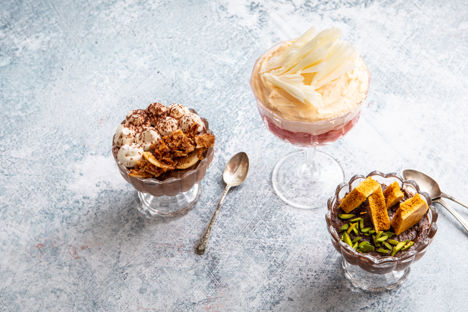Chocolate mousse is a guaranteed crowd-pleaser; light and airy with (often) an intense cocoa flavour, it’s incredibly easy to eat and is made with just a few ingredients. But while it’s theoretically simple to make a chocolate mousse there are a few important rules to follow to ensure success. Read our comprehensive guide on how to make chocolate mousse to ensure you get perfect results every time.
What are the components of chocolate mousse?
The components of a mousse are a base flavour (in this case that is obviously chocolate!), an aerating ingredient (eggs and/or whipped cream) and, sometimes, a thickener such as gelatin. There’s no need to use a thickener if you’re using a chocolate with a high percentage of cocoa solids, however.
How do you make chocolate mousse?
Chocolate mousse is made by melting chocolate in a bain marie, which is a bowl set over a saucepan of simmering water. It’s important not to let the simmering water touch the bottom of the bowl because this will cause the chocolate to turn into a thick, muddy paste or even burn. Aerating ingredients - whipped egg whites or whipped cream - are then added in order from the most stable to the least stable. This means yolks are added first, followed by whipped cream (if using) then whipped egg whites. The mixture is then set in the fridge for a few hours, or overnight.
What is the difference between French-style and American-style chocolate mousses?
French-style chocolate mousse is enriched with egg yolks and lightened with egg whites, resulting in an intense chocolate flavour. It’s denser and richer than American-style chocolate mousse, which contains whipped cream.
Which is the best chocolate for chocolate mousse?
We think that dark chocolate brings the most intense chocolate flavour to a mousse, and it makes sense to add the extra cocoa present in a dark chocolate when you will also be adding some extra sugar. Sometimes we use a mixture of dark and milk chocolate, but whatever you decide to use, it goes without saying that the better the quality of the chocolate, the better the end result.
How to make chocolate mousse
This is a very easy chocolate mousse recipe using just three ingredients.
Metric
Imperial
- 200g of dark chocolate, broken into small pieces
- 4 Freshlay Farms Golden Yolker® eggs, separated
- 3 tbsp of golden caster sugar
Melt the chocolate in a bowl set over a pan of simmering water, making sure the water doesn’t touch the bottom of the bowl
- 200g of dark chocolate, broken into small pieces
Once melted, set aside and allow the chocolate to cool until just warm to the touch. Stir in the egg yolks
- 4 Freshlay Farms Golden Yolker® eggs, separated
Whip the egg whites to soft peaks on medium speed before adding the sugar and whisking again to stiff peaks
- 3 tbsp of golden caster sugar
Fold the whipped egg whites into the mixture in 3 additions, making sure not to over mix
Transfer into serving dishes, cover and refrigerate for a couple of hours or overnight. Remove from the fridge 30 minutes before serving
Troubleshooting chocolate mousse
While chocolate mousse is a simple dessert with few ingredients, there are a few points at which things can go wrong. Read our tips below to ensure you end up with perfect chocolate mousse, every time.
Why is my chocolate mousse grainy?
Temperature is one of the most important factors to consider when making chocolate mousse. If your chocolate becomes grainy when you add the whipped egg whites or cream, it has cooled too much and hardened into small grains. Ideally, your chocolate should be between 35-40ºC before you incorporate the cooler ingredients.
If using cream, it’s possible that you over whipped it - aim for ‘barely soft peaks’.
If your chocolate has become thick, like a paste, while melting, you’ve overheated it. Make sure there’s no water touching the base of the bowl, and that the temperature isn’t too high. It’s also possible to burn chocolate by overheating.
How to whip egg whites for chocolate mousse
When whipping egg whites for chocolate mousse, make sure to whip at medium speed, which will produce more stable air bubbles than whipping on high speed, where the bubbles will form in an erratic style.
Make sure your bowl and whisk are absolutely dry and free of any grease, and beat the egg whites to the ‘barely soft peaks’ stage, rather than full soft peaks or stiff peaks. This will make the egg whites much easier to incorporate into other ingredients.
How to whip cream for chocolate mousse
Cream should always be cold for whipping, and it should be full fat (don’t attempt to whip lower fat cream - it’s not possible!). Take care not to over whip, as over whipped cream can make your chocolate mousse grainy.
Which flavours can you add to chocolate mousse?
Spices, such as black pepper, cinnamon, cardamom and chilli are natural pairings with chocolate. Try this chilli chocolate mousse or this spiced chocolate, black pepper and coffee mousse. Alcohol also works well, such as this Irish coffee mousse which contains Irish cream liqueur, while kirsch, rum and whisky all pair naturally with cocoa.
Nuts are a great choice too, for example peanut or hazelnut, and we also love to use sesame with chocolate (try our recipe for chocolate mousse with tahini cream and sesame brittle, below). Red fruits such as cherries and raspberries work best with dark chocolate while milk chocolate pairs particularly well with orange. White chocolate benefits from the addition of something acidic, such as passion fruit or rhubarb.
Get in touch
Please sign in or register to send a comment to Great British Chefs.


